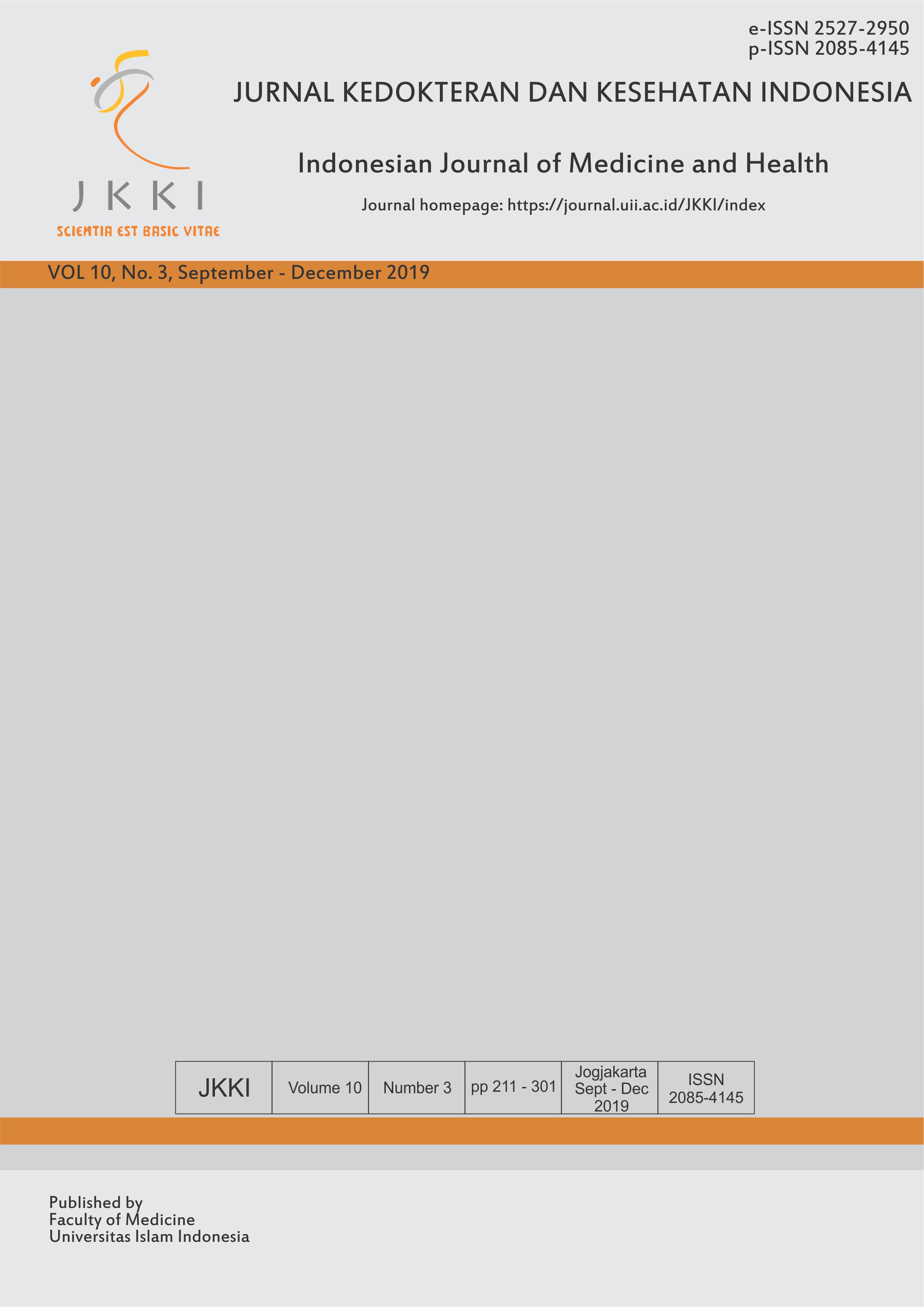Main Article Content
Abstract
Background: Controlling of dengue vectors around dengue haemorrhagic fever cases is often conducted by using insecticides, including a malathion insecticide in the city of Semarang. A research on susceptibility status of Ae. aegypti to insecticides, used for fogging and based on a high number of hemorrhagic fever cases in Tembalang district, Semarang city, needs to be observed.
Objective: This study aimed to determine resistance status of Ae. aegypti mosquitoes based on bioassay and biochemical tests of esterase non-specific enzyme activity in the Tembalang District.
Methods: This study used a cross sectional design, it was conducted in June-September 2018 in a population of Aedes sp. from Tembalang District, Semarang City. Samples of F2 generations of female Ae. aegypti were obtained by ovitraps in the Tembalang District consisting of 12 urban villages, and their resistance status were tested by impregnated paper bioassay with malathion at a diagnostic dose of 0.8%. Esterase enzyme activity in the Ae. aegypti mosquito body of this population was tested biochemically to prove an increase in a non-specific esterase enzyme on the a-naphthyl acetate substrate.
Results: The bioassay results showed that mortality rates of Ae. aegypti at the 12 villages in Tembalang district after 24 hourtest by impregnated paper indicated a range of 0-62%. Mechanism of resistance indicating an increase of non-specific enzyme esterase activity on a-naphthyl acetate at Rowosari, Kedungmundu, Sambiroto, and Meteseh could not be seen, It began to be seen in a low percentage (15%) at Sendang Mulyo, Tandang, Sendangguwo and Bubusan, and in a moderate percentage (45-75%) in Tembalang, Jangli and Mangunharjo. The mechanism of high esterase enzyme activity could be seen in the Ae. aegypti population at Kramas with AV=0,700-0,900 by a percentage of 20%, and AV=0,900 by a percentage of 80%.
Conclusion: This study provided information about some Ae. aegypti mosquitoes from Tembalang District that showed resistance to the malathion insecticide with an elevation of non-specific esterase enzyme activity ona-naphthyl acetate substrate in several villages except Kelurahan Rowosari, Kedungmundu, Sambiroto, and Meteseh.
Keywords
Article Details
Authors who publish in the Jurnal Kedokteran dan Kesehatan Indonesia agree to the following terms:
- Authors retain copyright and grant Jurnal Kedokteran dan Kesehatan Indonesia right of first publication with the work simultaneously licensed under a Creative Commons Attribution Licence that allows others to adapt (remix, transform, and build) upon the work non-commercially with an acknowledgement of the work's authorship and initial publication in Jurnal Kedokteran dan Kesehatan Indonesia.
- Authors are permitted to share (copy and redistribute) the journal's published version of the work non-commercially (e.g., post it to an institutional repository or publish it in a book), with an acknowledgement of its initial publication in Jurnal Kedokteran dan Kesehatan Indonesia.
References
- WHO. Demam berdarah dengue: diagnosis, pengobatan, pencegahan & pengendalian (Edisi 2)EGC Jakarta.; 2016.
- WHO. Media center dengue and dengue haemorrhagic fever. Jakarta: WHO; 2016.
- Kementerian Kesehatan RI. Pedoman pengendalian demam berdarah dengue di Indonesia. Dirjen P2P&PL. Jakarta; 2016.
- Dinas Kesehatan Kota Semarang. Profil kesehatan kota Semarang 2016. Dinas Kesehat Kota Semarang. 2017:1-102.
- Kementerian Kesehatan RI. Pedoman penggunaan insektisida (pestisida) dalam pengendalian vektor.Jakarta; 2012.
- WHO. Monitoring and managing insecticide resistance in Aedes mosquito populations Interim guidance for entomologists.Geneva: WHO. 2016
- Martini HR, Widjanarko B, Purwantisari S. Resistance of Aedes as a vectors potential for dengue hemorrhagic fever ( DHF ) in Semarang city, Indonesia. Journal Of Tropical Life Science. 2019;9(1):89-94.
- Soenjono SJ, Pandean M. Status resistensi vektor demam berdarah dengue Aedes aegypti terhadap malathion di kota Tomohon resistance status of Aedes aegypti against malathion, in Tomohon city. 2017; 11 (2):43-48.
- Iswidaty, T., Martini. WD. Status resistensi nyamuk Aedes Aegypti terhadap malathion 0,8 % di area perimeter dan buffer pelabuhan Tanjung Emas Semarang (pengujian berdasarkan teknik bioassay dan biokimia). Jurnal Kesehatan Masyarakat Universitas Diponegoro. 2016;4(1):211-7.
- Jackson CJ, Liu J, Carr PD, et al. Structure and function of an insect a -carboxylesterase ( a Esterase 7 ) associated with insecticide resistance. 2013;110(25):10177-82.
- Raini M. Toksikologi pestisida dan penanganan akibat keracunan pestisida. Media Penelitian dan Pengembangan Kesehatan. 2007.17 (3):10-8
- Widiastuti D, Ikawati B. Resistensi malathion dan aktivitas enzim esterase pada populasi nyamuk Aedes aegypti di kabupaten Pekalongan Malathion Resistance And Esterase Enzyme Activity Of Aedes aegypti Population In Pekalongan. BALABA. 2016.12 (2):61-70.
References
WHO. Demam berdarah dengue: diagnosis, pengobatan, pencegahan & pengendalian (Edisi 2)EGC Jakarta.; 2016.
WHO. Media center dengue and dengue haemorrhagic fever. Jakarta: WHO; 2016.
Kementerian Kesehatan RI. Pedoman pengendalian demam berdarah dengue di Indonesia. Dirjen P2P&PL. Jakarta; 2016.
Dinas Kesehatan Kota Semarang. Profil kesehatan kota Semarang 2016. Dinas Kesehat Kota Semarang. 2017:1-102.
Kementerian Kesehatan RI. Pedoman penggunaan insektisida (pestisida) dalam pengendalian vektor.Jakarta; 2012.
WHO. Monitoring and managing insecticide resistance in Aedes mosquito populations Interim guidance for entomologists.Geneva: WHO. 2016
Martini HR, Widjanarko B, Purwantisari S. Resistance of Aedes as a vectors potential for dengue hemorrhagic fever ( DHF ) in Semarang city, Indonesia. Journal Of Tropical Life Science. 2019;9(1):89-94.
Soenjono SJ, Pandean M. Status resistensi vektor demam berdarah dengue Aedes aegypti terhadap malathion di kota Tomohon resistance status of Aedes aegypti against malathion, in Tomohon city. 2017; 11 (2):43-48.
Iswidaty, T., Martini. WD. Status resistensi nyamuk Aedes Aegypti terhadap malathion 0,8 % di area perimeter dan buffer pelabuhan Tanjung Emas Semarang (pengujian berdasarkan teknik bioassay dan biokimia). Jurnal Kesehatan Masyarakat Universitas Diponegoro. 2016;4(1):211-7.
Jackson CJ, Liu J, Carr PD, et al. Structure and function of an insect a -carboxylesterase ( a Esterase 7 ) associated with insecticide resistance. 2013;110(25):10177-82.
Raini M. Toksikologi pestisida dan penanganan akibat keracunan pestisida. Media Penelitian dan Pengembangan Kesehatan. 2007.17 (3):10-8
Widiastuti D, Ikawati B. Resistensi malathion dan aktivitas enzim esterase pada populasi nyamuk Aedes aegypti di kabupaten Pekalongan Malathion Resistance And Esterase Enzyme Activity Of Aedes aegypti Population In Pekalongan. BALABA. 2016.12 (2):61-70.
